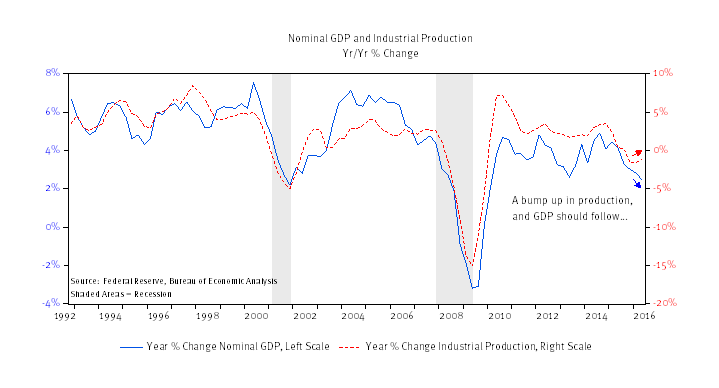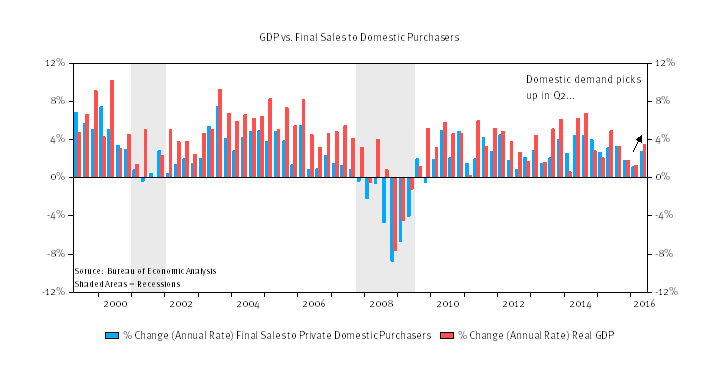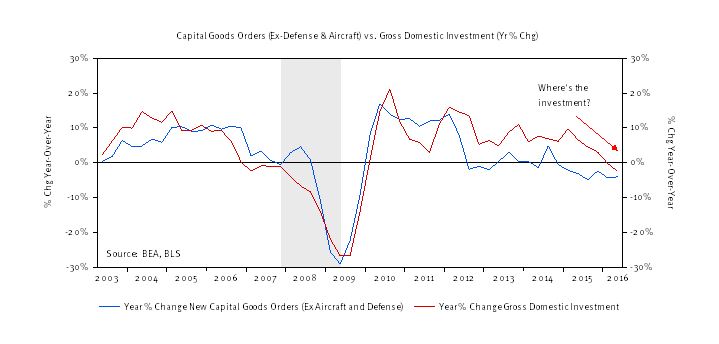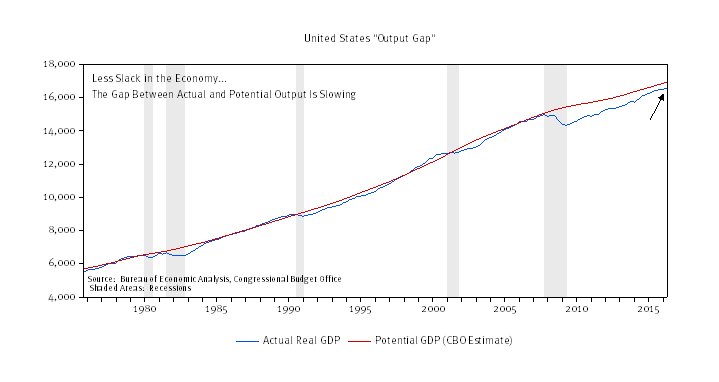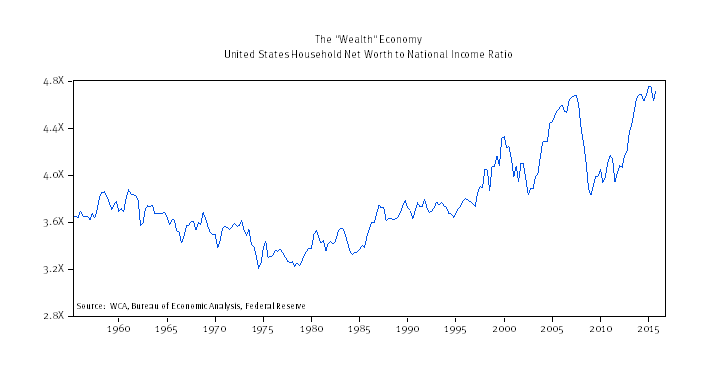Viewpoint
Friday’s July employment report is the big number this week. This indicator is a focal point for the Federal Reserve (Fed) and has been very erratic of late. The 6,000 job loss in May was shockingly poor, but it was followed by a better-than-expected 265,000 job gain in June. Will the real labor market please stand up? A Bloomberg survey reveals a street expectation of 171,000 jobs and a 4.8% inflation rate.
MACRO VIEW
Last week’s Gross Domestic Product (GDP) report showed an economy growing at just 1.2%. This headline figure will be revised further, but taken at face value, it indicates a growth rate below our 2016 forecast (2.25%). The current estimated growth rate for the first half is near 1%, a full 1.25% light of our full-year expectation. To hit our initial forecast, we would need to see real growth of 3.5% through the second half of the year. This would be a tall order, but not impossible. A recent uptick in our WCA Fundamental Conditions Barometer provides some reason for optimism that the second half will, at least, be better than the first. Ultimately, the direction is what is most important, and there are some things to cheer in this regard looking at the second quarter’s performance.
The slide in industrial production, which accompanied the slowdown in growth, seems to be easing (Chart A below). Domestic demand, measured by final sales to domestic purchasers, saw a pickup in the second quarter and helped drive the small improvement in total output (Chart B, below). Capital goods orders, a proxy for business investment, appears to be stabilizing. What we haven’t seen yet has been a pickup in investment (Chart C, below). Gross private investment contracted at an annualized rate of nearly 10% in the second quarter on an annual basis. The decline in overall investment was accompanied by a decline in private, single family residential investment (-16% annualized). Perhaps something to consider here is the fact that the average price of a new home in the United States is up 50% from the recession low and 20% from pre-recession levels. Could affordability, once again, be an issue?
Chart A
Chart B
Chart C
Ultimately, the economy remains on an expansion path. Although slow, the steady progress in the United States is better than many countries around the world. Combined with slower growth in the workforce, investment, and productivity growth, there seems to be less slack in the economy. The “output gap” is narrower now than any time in the recovery to date, according to estimates from the Congressional Budget Office and the Bureau of Economic Analysis (Chart D, below). Firming prices, coupled with less slack, form the basis for the case for rate normalization. Core consumer prices are up 2.4% over the last 6-months, annualized). The market cap for U.S. stocks is near a record $25 trillion. The S&P CoreLogic Case-Shiller U.S. National Home Price Index is back near record levels. Overall, the ratio of household net worth (i.e. “wealth”) to national income is back to levels seen before the recession (Chart E, below). A narrowing “output gap,” above 2% core consumer prices, and a restoration of financial wealth all argue for rate normalization.
Chart D
Chart E
Despite these trends, the Federal Reserve chose to leave rates unchanged when they met last week. The Federal Open Market Committee (FOMC) focus on the weak May jobs report seems to be the reason most often cited for why the Fed has dialed back their rhetoric over a faster rate normalization. The risk is that the May data turns out to be an aberration and the Fed ends up being “behind the curve.”
As for the official data on the economy’s growth, we are pleased to see some forward progress and expect this progress to continue into the second half.
ECONOMIC RELEASES THIS WEEK
| Date | Report | Period | Survey | Prior |
| Monday, August 1: | ISM Manufacturing Index | July | 53.0 | 53.2 |
| PMI Manufacturing Index | July | — | 52.9 | |
| Construction Spending M/M | June | 0.5% | -0.8% | |
| Tuesday, August 2: | Personal Income | June | 0.3% | 0.2% |
| Personal Spending | June | 0.3% | 0.4% | |
| Domestic Vehicle Sales | July | — | 12.8 M | |
| Total Vehicle Sales | July | 17.1 M | 16.6 M | |
| Wednesday, August 3: | ADP Employment Report | July | 168 K | 172 K |
| ISM Non-Manufacturing Index | July | 56.1 | 56.5 | |
| Thursday, August 4: | Weekly Jobless Claims | July 30 | — | 266 K |
| Factory Orders M/M | June | -1.8% | -1.0% | |
| Friday, August 5: | Change in Nonfarm Payrolls | July | 178 K | 287 K |
| Unemployment Rate | July | 4.8% | 4.9% | |
| Labor Force Participation Rate | July | — | 62.7% | |
| Underemployment Rate | July | 90.5 | 9.6% | |
| International Trade Balance | June | -$42.0 B | -$41.1 B | |
ASSET ALLOCATION PORTFOLIO POSTURE
LONG-RUN STRATEGIC POSTURE: Our long-run forecasts lead us to overweight large cap domestic growth stocks, high-yield corporate bonds, and gold in the diversified “core” of portfolios. Underweight positions in “core” are long-term U.S. Treasuries, foreign developed equities, and REITs. Meanwhile the equity allocation in the short-term tactical “satellite” portion of portfolios was increased to 40% equity / 60% fixed income from 33% equity / 66% fixed income. Mid-year rebalancing took place at the end of June to reflect updated long-run forecasts.
The information contained herein has been prepared from sources believed to be reliable but is not guaranteed by us and is not a complete summary or statement of all available data, nor is it considered an offer to buy or sell any securities referred to herein. Opinions expressed are subject to change without notice and do not take into account the particular investment objectives, financial situation, or needs of individual investors. There is no guarantee that the figures or opinions forecasted in this report will be realized or achieved. Employees of Stifel, Nicolaus & Company, Incorporated or its affiliates may, at times, release written or oral commentary, technical analysis, or trading strategies that differ from the opinions expressed within. Past performance is no guarantee of future results. Indices are unmanaged, and you cannot invest directly in an index.
Asset allocation and diversification do not ensure a profit and may not protect against loss. There are special considerations associated with international investing, including the risk of currency fluctuations and political and economic events. Investing in emerging markets may involve greater risk and volatility than investing in more developed countries. Due to their narrow focus, sector-based investments typically exhibit greater volatility. Small company stocks are typically more volatile and carry additional risks, since smaller companies generally are not as well established as larger companies. Property values can fall due to environmental, economic, or other reasons, and changes in interest rates can negatively impact the performance of real estate companies. When investing in bonds, it is important to note that as interest rates rise, bond prices will fall. High-yield bonds have greater credit risk than higher quality bonds. The risk of loss in trading commodities and futures can be substantial. You should therefore carefully consider whether such trading is suitable for you in light of your financial condition. The high degree of leverage that is often obtainable in commodity trading can work against you as well as for you. The use of leverage can lead to large losses as well as gains.
The WCA Fundamental Conditions Barometer measures the breadth of changes to a wide variety of fundamental data. The barometer measures the proportion of indicators under review that are moving up or down together. A barometer reading above 50 generally indicates a more bullish environment for the economy and equities, and a lower reading implies the opposite. Quantifying changes this way helps us incorporate new facts into our near-term outlook in an objective and unbiased way. More information on the barometer is found in our latest quarterly report, available at www.washingtoncrossingadvisors.com/insights.html.
Client-approved reports and commentaries click here
Kevin Caron, Portfolio Manager
Chad Morganlander, Portfolio Manager
Matthew Battipaglia, Analyst
Suzanne Ashley, Junior Analyst
(973) 549-4052

